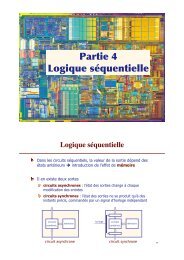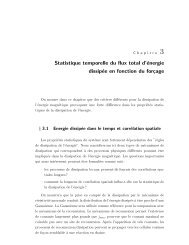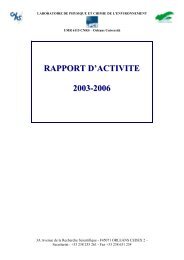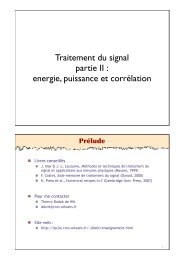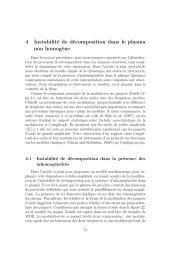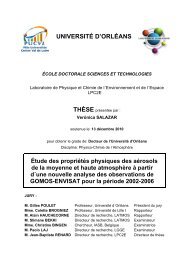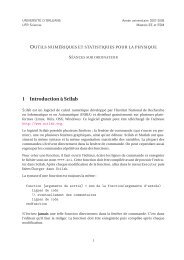UNIVERSITÉ D'ORLÉANS - Laboratoire de physique et chimie de l ...
UNIVERSITÉ D'ORLÉANS - Laboratoire de physique et chimie de l ...
UNIVERSITÉ D'ORLÉANS - Laboratoire de physique et chimie de l ...
You also want an ePaper? Increase the reach of your titles
YUMPU automatically turns print PDFs into web optimized ePapers that Google loves.
found at an almost constant value of 360 K, i.e. ~15±0.5 km (G<strong>et</strong>telman, <strong>et</strong> al., 2004;<br />
Fueglistaler <strong>et</strong> al., 2008). The tropopause heights for both flights were <strong>de</strong>rived from high<br />
resolution measurements of temperature performed aboard the gondola. Vertical profiles of<br />
temperature are shown in Fig. 2 with the CPT indicated. The CPT was higher and col<strong>de</strong>r in<br />
June 2008 (16.78 km; –83.0 °C) than in June 2005 (16.25 km; –79.9 °C).<br />
Since air parcels above the LZRH are expected to move slowly to the stratosphere (G<strong>et</strong>telman<br />
<strong>et</strong> al., 2004), the HCl amounts potentially present above this level will be further transported<br />
into the stratosphere. Strong convection in combination with HCl tropospheric source areas<br />
arising from <strong>de</strong>chlorination of sea-salt aerosols (WMO 2007; Kim <strong>et</strong> al., 2008) or volcanoes<br />
(Edmonds <strong>et</strong> al., 2002) can influence the HCl amounts present in the TTL. Stratosphere-to-<br />
troposphere transport can also affect the chlorine content of the TTL (Marcy <strong>et</strong> al., 2004).<br />
Therefore trajectory calculations are a useful tool to <strong>de</strong>termine if such upward or downward<br />
transport has occurred prior to SPIRALE measurements. Of course, one must keep in mind<br />
that subgrid convection is not resolved in three-dimensional trajectories (e.g. Berth<strong>et</strong> <strong>et</strong> al.<br />
2007b) so that our calculations possibly miss advection due to individual convective cells.<br />
Figure 3 shows the 7 day backward trajectories of air masses reaching the SPIRALE<br />
measurements vicinity in the 15–17.5 km altitu<strong>de</strong> range (i.e. including the upper TTL and<br />
lower stratosphere) for the June 2005 and the June 2008 flights. According to this figure, the<br />
air masses sampled in June 2005 originated southwest and northwest of Teresina. The air<br />
masses probed by SPIRALE in 2005 at and above the LZRH did not un<strong>de</strong>rgo significant<br />
upward or downward transport at least 7 days before the flight. For June 2008, the backward<br />
trajectories reveal that air masses originated west (around 15.5 km) and east (around 17 km)<br />
of Teresina. Despite these distinct air mass origins, an agreement is found with the<br />
corresponding HCl values obtained in 2005 in the upper TTL. As in 2005, Fig. 3b also<br />
indicates that transport insi<strong>de</strong> this region in June 2008 occurred predominantly at constant<br />
altitu<strong>de</strong>s with no downward motion and limited upward motion prior to the SPIRALE flight.<br />
This reveals unfavourable conditions for fast transport of trace gases vertically from the<br />
troposphere to the TTL as well as transport of stratospheric air into the TTL. Since the TTL is<br />
an exchange zone, air masses in this region might be exposed to those from above. On short<br />
time-scales, episodic stratospheric intrusions may pen<strong>et</strong>rate from the extra-tropics down to the<br />
TTL. Potential vorticity fields, which are useful tools to highlight such relatively “sporadic”<br />
phenomena (see, e.g. Waugh and Polvani, 2000), have been calculated over the few days<br />
preceding the SPIRALE observations and did not show any evi<strong>de</strong>nce for stratospheric<br />
117



